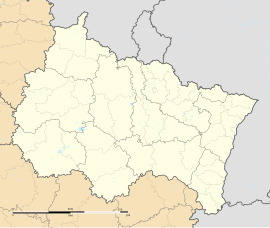Chaumont-devant-Damvillers (French pronunciation: [ʃomɔ̃ dəvɑ̃ dɑ̃vile], lit. 'Chaumont before Damvillers') is a commune in the Meuse department in Grand Est in north-eastern France. It is known as the place where the last soldier to die in the First World War was killed, when American Henry Gunther died charging a German position sixty seconds before the Armistice came into effect.[3]
Chaumont-devant-Damvillers | |
|---|---|
| Coordinates: 49°18′28″N 5°25′35″E / 49.3078°N 5.4264°E | |
| Country | France |
| Region | Grand Est |
| Department | Meuse |
| Arrondissement | Verdun |
| Canton | Montmédy |
| Intercommunality | CC Damvillers Spincourt |
| Government | |
| • Mayor (2020–2026) | Yannick Jeanjean[1] |
| Area 1 | 5.35 km2 (2.07 sq mi) |
| Population (2021)[2] | 47 |
| • Density | 8.8/km2 (23/sq mi) |
| Time zone | UTC+01:00 (CET) |
| • Summer (DST) | UTC+02:00 (CEST) |
| INSEE/Postal code | 55107 /55150 |
| Elevation | 218–329 m (715–1,079 ft) (avg. 235 m or 771 ft) |
| 1 French Land Register data, which excludes lakes, ponds, glaciers > 1 km2 (0.386 sq mi or 247 acres) and river estuaries. | |
See also
editReferences
editWikimedia Commons has media related to Chaumont-devant-Damvillers.
- ^ "Répertoire national des élus: les maires". data.gouv.fr, Plateforme ouverte des données publiques françaises (in French). 2 December 2020.
- ^ "Populations légales 2021" (in French). The National Institute of Statistics and Economic Studies. 28 December 2023.
- ^ Best, Nicholas (2008). The Greatest Day in History - How, On the Eleventh Hour of the Eleventh Day of the Eleventh Month, The First World War Finally Came To An End. United States: PublicAffairs. p. 199. ISBN 9781586486402.



